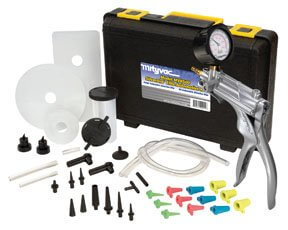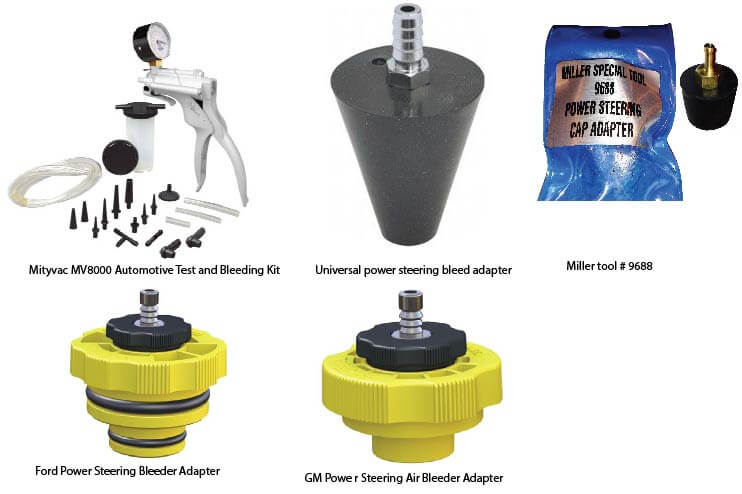How to Bleed power steering
Bleed power steering
Why you must bleed power steering
If you’ve replaced a power steering hose, pump, or rack, you must bleed power steering to remove air from the system. If you don’t bleed the power steering, the air in the system will cause the power steering fluid to foam and foam doesn’t cool well or provide power assist. Worse than that, however, air in a power steering pump causes cavitation, which can destroy the pump.
Two ways to bleed power steering
One method you’ll see online and in some instruction manuals is to start the engine and turn the steering wheel full left and full right. This is referred to as the “lock-to-lock” method. It is an old and very outdated method that should not be used on late model vehicles.
The second method is to use a hand-held vacuum pump to apply a vacuum to the entire power steering system.
Why you shouldn’t turn the steering lock to lock to bleed power steering
The power steering system is capable of generating up to 2,000-psi when the wheel is turned to full left or full right with the engine running. Leaving the wheel in full lock position for longer than 1-2 seconds can damage the power steering hoses, pump vanes and blow out seals in the power steering gear.
On a hybrid hydraulic/electric steering system, where the pump is driven by an electric motor instead of a belt, turning the wheel lock to lock can cause the pump motor to overheat. That, in turn, causes a check engine light and a complete shutdown of the power steering assist system. You’ll still have manual steering, but the steering wheel will be very hard to turn.
Bleed power steering with a vacuum pump
Once you’ve refilled the power steering pump reservoir,

Mityvac MITMV8500 Silverline Elite Automotive Vacuum Pump Kit. Click on image to purchase from Amazon
remove air pockets in the steering gear by turning the steering wheel full left and full right WITH THE ENGINE OFF! You’ll see air bubbles coming up into the reservoir and that a good sign. It confirms that the gear is pushing air out of the piston areas. Then move on to the vacuum bleeding procedure
Install vacuum adapter into power steering reservoir
Use a universal or vehicle specific reservoir adapter to apply vacuum to the power steering system. Then, using a handheld vacuum pump and catch bottle, apply 25-in Hg of vacuum to the system. Let the vacuum sit for a minimum of five minutes, or until you no longer see bubbles. Slowly release the vacuum. Install the factory reservoir cap and start the engine. If you hear any whining when turning the steering wheel, repeat the procedure. If you still have air, start the engine and turn the wheel full left and full right, but DO NOT hold the wheel and the end of travel. Repeat the vacuum procedure one last time.

Power steering vacuum bleed adapters
Chrysler warns against using the lock to lock procedure
Chrysler has issued a technical service bulletin TSB #19-008-05 REV. A with explicit instructions on how to bleed power steering systems on most of its vehicles. The TSB warns that if air is not purged from the system, the power steering pump can be damaged.
Start by filling the reservoir to the proper level. Install the P.S. cap adapter (Miller tool # 9688) onto the pump reservoir. Use a hand vacuum pump and pull a 20-25-inch vacuum on the system. Hold the vacuum for a minimum of 3 minutes. Then recheck fluid level. If the fluid level is now lower, repeat the procedure. Continue to repeat until the fluid level stops falling after vacuum is released. Chrysler also warns NOT TO TURN THE STEERING WHEEL stop to stop is is customarily done in the auto repair industry.
© 2012 Rick Muscoplat
Posted on by Rick Muscoplat